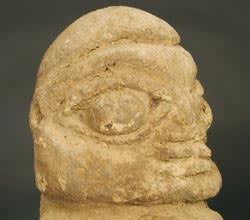Yoruba Stone Altar Figure, 1500 CE - 1800 CE
Stone
5 x 15.25
PF.5103
Further images
Stylistic similarities between this figure and those from the much early period of Nok (600 BC - 200 AD), suggest a continuous tradition of artistic form and religious belief. Distinctive...
Stylistic similarities between this figure and those from the much early period of Nok (600 BC - 200 AD), suggest a continuous tradition of artistic form and religious belief. Distinctive Yoruba features evident in the wide span of their art are apparent in this sculpture--principally the large bulbous eyes, broad face and heavy cheeks. The figure is highly compact in the sense the hands are pressed tightly together over the abdomen, legs tucked underneath, knees pressed together, exposed genitals placed precisely in the center. A hieratic (sacerdotal) pose is thus created and heightened by the intensely staring eyes and the very human, yet other worldly feeling from the figure. Intended to be placed on an altar, dedicated to a deity/deities, or ancestral worship, the back of the sculpture may have been intentionally flattened to be flush against a wall as a permanent element of the altar statuary. The belief that ancestors play an active role as spiritual benefactors for the living gains concrete expression in this powerful sculpture.





